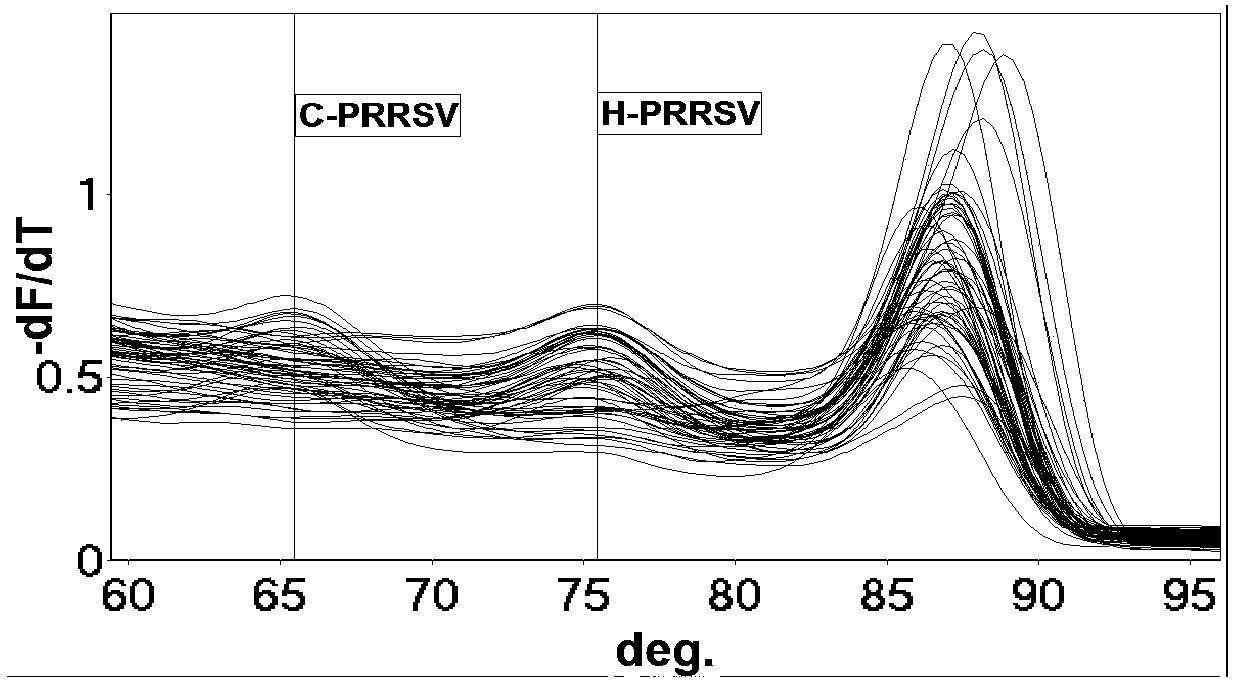A hrm non-labeled probe method for rapidly distinguishing prrsv classic strains and variant strains and its primers and probes
A technology of classic strains and mutant strains, applied in the direction of microorganism-based methods, biochemical equipment and methods, microorganisms, etc., can solve the problems of PCR product contamination, high price, low sensitivity, etc., and achieve high-throughput analysis and accurate High performance and good repeatability
- Summary
- Abstract
- Description
- Claims
- Application Information
AI Technical Summary
Problems solved by technology
Method used
Image
Examples
Embodiment 1
[0058] Example 1 A kind of HRM unlabeled probe method for rapidly distinguishing PRRSV classic strains and mutant strains
[0059] Primers and Unlabeled Probes
[0060] 1) PCR pre-amplification primers
[0061] According to the gene sequences of H-PRRSV (PRRSV variant strain) and C-PRRSV (PRRSV classic strain), primer pairs P1 and P2 (PCR pre-amplification primers) for amplifying partial gene fragments of H-PRRSV and C-PRRSV were designed, Its base sequence is shown below.
[0062] P1: 5'-GAYATTCATCATTACACCAGT-3' (SEQ ID NO: 1),
[0063] P2: 5'-AACACYCCGCCAGAGCC-3' (SEQ ID NO: 2).
[0064] 2) PCR-HRM primers:
[0065] After screening a large number of designed primers, it was found that the base sequences of the primers SEQ ID NO: 3 and SEQ ID NO: 4 have the best effect on the PCR-HRM method for distinguishing classic and mutant strains of PRRSV, and their base sequences are as follows .
[0066] P3: 5'-GCYACCGCACCAGATGGRACCTACTT-3' (SEQ ID NO: 3),
[0067] P4: 5'-ACGGT...
Embodiment 2
[0071] Example 2 A HRM non-labeled probe method for rapidly distinguishing PRRSV classic strains and variant strains
[0072] PCR-HRM analysis of standard samples
[0073] 1) Extraction of PRRSV standard nucleic acid:
[0074] Take CH-1R vaccine (C-PRRSV classic strain) and JXA1-R vaccine (H-PRRSV variant strain) respectively and add 3mL of PBS hydrochloric acid buffer solution to dissolve, take 200μL according to TAKARA's MiniBEST Viral RNA / DNA ExtractionKit Ver.4.0 Instructions for nucleic acid extraction.
[0075] 2) PCR-HRM operation steps for positive standard samples
[0076] In order to verify the ability of the designed primers and non-standard probes to identify actual samples, CH-1R vaccine (C-PRRSV classic strain) and JXA1-R vaccine (H-PRRSV variant strain) were used as standard samples in this study Perform PCR-HRM analysis. The above-mentioned standard samples were used to extract nucleic acids as nucleic acid templates, and the PCR-HRM pre-amplification react...
Embodiment 3
[0089] Example 3 PCR-HRM analysis of clinical samples
[0090] 1) Extract viral nucleic acid from samples: Take 2g of pig lung tissue samples suspected to be infected with C-PRRSV classic strain and H-PRRSV vaccine strain, add 3mL PBS hydrochloric acid buffer solution for grinding, and grind the homogenate 4000 Centrifuge at × g for 8 min, and absorb the centrifuged supernatant and store it at -80°C for later use. Or serum samples 200 μL tissue sample homogenate and serum samples were subjected to nucleic acid extraction according to the instructions of TAKARA's MiniBEST Viral RNA / DNA Extraction Kit Ver.4.0.
[0091] 2) Use the extracted viral nucleic acid as a template to perform RT-PCR pre-amplification (refer to the PrimeScript® One Step RT-PCR Kit kit instructions), and the pre-amplification reaction system is:
[0092]
[0093] The pre-amplification reaction program was reverse transcription at 50°C for 30 min; pre-denaturation at 95°C for 2 min; denaturation at 95°C ...
PUM
 Login to View More
Login to View More Abstract
Description
Claims
Application Information
 Login to View More
Login to View More - R&D
- Intellectual Property
- Life Sciences
- Materials
- Tech Scout
- Unparalleled Data Quality
- Higher Quality Content
- 60% Fewer Hallucinations
Browse by: Latest US Patents, China's latest patents, Technical Efficacy Thesaurus, Application Domain, Technology Topic, Popular Technical Reports.
© 2025 PatSnap. All rights reserved.Legal|Privacy policy|Modern Slavery Act Transparency Statement|Sitemap|About US| Contact US: help@patsnap.com



